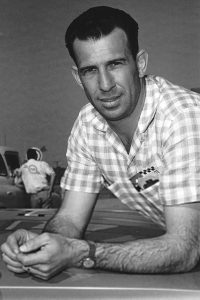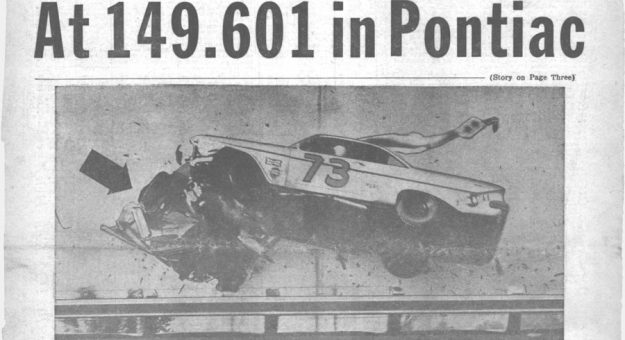Editor’s Note: NASCAR is celebrating its 75th anniversary in 2023. SPEED SPORT was founded in 1934 and was already on its way to becoming America’s Motorsports Authority when NASCAR was formed. As a result, we will bring you Part 14 of a 75-part series on the history of NASCAR as told in the pages of National Speed Sport News and SPEED SPORT Magazine.
It was a turbulent year in NASCAR.
“Quietly and without fanfare, well-known race drivers, headed by Curtis Turner and “Fireball” Roberts met in Chicago last week with representatives of the Jimmy Hoffa-controlled Teamsters Union. The purpose was to form a union of all professional drivers,” reported the Aug. 16 issue of NSSN.
Turner, who resigned in July as president of the financially troubled Charlotte Motor Speedway, explained why he sought to unionize NASCAR drivers and mechanics into the Teamsters Union-affiliated Federation of Professional Athletes in the following week’s edition of NSSN.
He wrote that while purses had risen at NASCAR events, drivers were expected to spend more pre-race time at the tracks for practice and qualifying, thus increasing their labor and materials costs and diminishing the larger winnings. Turner felt drivers should receive 40 percent of the track’s time-trial profits from admission in addition to the race prizes.
The 16-time Grand National victor further detailed the FPA’s demands, which included a pension fund for the drivers, death benefits for families of fatally injured drivers, health benefits and a scholarship fund for children of deceased NASCAR members.
A procedure for driver complaints and improvements in safety conditions were also proposed in the open letter Turner addressed to all drivers.
Drivers Suspended, NASCAR Takes A Stand
Not surprisingly, Bill France’s reaction to the union’s attempt to organize NASCAR drivers and mechanics was quick and severe. “No known teamster members can compete in a NASCAR race, and if this isn’t tough, I’ll use a pistol to enforce it,” he threatened. “I am barring union members from races to protect the drivers who do not sign up (from physical harm).”
France immediately suspended top drivers Turner, Roberts and Tim Flock for participating in organization of the union. Only Roberts was reinstated later the same week (Aug. 10-16) when he considered his stand’s effect on other drivers.

“The Teamsters people have implied that to force this issue there might be injunctions and litigations which might disrupt all racing,” he stated in the Aug. 16 issue. “If this happened there might be a lot of individuals who would be hurt very badly … I feel if I do anything to hurt the least man in racing, I will be doing a disservice to my fellow drivers-and I’ll have no part of it.”
Roberts’ return to NASCAR did not dissuade Turner, who also sought to introduce parimutuel betting into automobile racing.
In the final months of 1961, he filed a legal suit against the sanctioning body for $200,000 in damages and sought an injunction to prohibit NASCAR from banning drivers who belonged to the FPA. Although he claimed a majority of Grand National drivers had signed applications for union membership, Turner’s efforts failed to gain overt support in the ranks of NASCAR drivers and mechanics.
In January of 1962, NSSN reported Turner quit the FPA to concentrate on promoting Midwest Ass’n of Race Cars events.
While the turmoil inflicted by the FPA’s attempt to unionize NASCAR was unwanted, it did place NASCAR and its rival, the United States Auto Club, on the same side for the first time. In January, the sanctioning body behind the Indianapolis 500 banned its top drivers from participating in the Daytona 500 despite France’s invitation.
USAC’s position was that France was simply trying to increase his gate receipts by featuring its renowned drivers such as 1960 Indianapolis 500 victor Jim Rathmann.
On the other hand, NASCAR held that the Daytona 500, as a Federation Intemationale de l’Automobile “Full International” race open to all F1A members, was open to all USAC drivers who also belonged to the international sanctioning body. Only a conference between France and USAC President Tom Binford, mediated by ACCUS/FIA President Charles Moran Jr., eased this dispute with a compromise: for the Daytona 500 only, USAC drivers and their crews would be allowed to participate in a NASCAR-sanctioned event.
‘You Can’t Do Business With NASCAR’
Four months later, Binford was quoted in the May 24 issue of NSSN as saying, “You just can’t do business with NASCAR.”
He was referring to France’s insistence that a deal had been struck to allow NASCAR drivers to participate in a USAC-sanctioned stock car race in Milwaukee on Aug. 17. USAC denied any knowledge of such an agreement and added that NASCAR had blocked participation of its drivers in a USAC stock car race in Concord, N.C. on Apri12. This dispute was not resolved and Paul Goldsmith, the USAC driver who finished third in the Daytona 500, remained the only man to drive for both organizations this season.
Amid the off-the-track agitations, the NASCAR Grand National drivers raced through a schedule of 52 dates. Fireball Roberts won the Daytona 500 for the second consecutive year and had another profitable year despite running his normal abbreviated slate of races. He earned $50,267 from the 22 races he entered, including a flag-to-flag victory in the 250-mile race at Marchbanks Speedway in Hanford, Calif.
His earnings were the third highest after David Pearson’s $51,911 and defending champ Rex White’s $56,395 year.
White’s monetary success followed his seven victories and 38 top-10 finishes, which gave him second in the standings behind 1961 champion Ned Jarrett. Jarrett did not compile a record which normally indicates a title year. Jarrett did not lead the most laps (Junior Johnson) or the most races (Johnson) and he only captured four poles.
Petty’s Out For The Year
Eleven other drivers won more than the one race he won, yet Jarrett’s consistency garnered him the Grand National crown.
Three-time champion, Lee Petty, did not fare as well in 1961. After a victory in the second race of the season, Petty crashed while racing in a 100-mile qualifying event for the Daytona 500. As he attempted to pass Jim Pardue in Daytona’s east turn, Johnny Beauchamp hit Petty from behind and drove him through the rail and over the apron onto the tunnel road below.
Petty’s car was in shambles, but his seat belt kept him in his seat for the horrifying crash. He was taken to the hospital in serious condition with a punctured lung, multiple fractures of his left chest, a fractured left thigh and collarbone and multiple internal injuries.
Fortunately, Petty and Beauchamp, who received multiple head injuries, recovered, though Petty was out for the year.
At the end of a tumultuous year, Johnny Roberts captured his second consecutive modified title.
Other awards went to Woodrow “Woodie” Wilson, the modified and sportsman veteran, who became a 36-year-old rookie of the year on the Grand National circuit and Jarrett’s mechanic, Birch A. “Bud” Allman, was the mechanic of the year. Joe Weatherly was named most popular driver.
